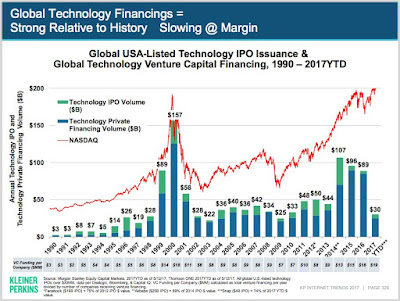2Q 2017 figures for seed funding and startups capital rounds is in, and the slow bleeding of the Silicon Dreams appears to be entering a new, accelerated stage.
Seed funding posted continuous declines over the last two years, falling some 40 percent on 3Q 2015 peak in terms of number of transactions and down 24 percent in volume.
Source: PitchBook Inc
Combined seed and angel investment deals numbered just 900 on 2Q 2017, down 200 on same period in 2016 and well below ca 1,500 deals completed in 2Q 2015. In volume terms, 2Q 2017 came in with total investment of $1.65 billion, down on $1.75 billion in 2Q 2016 and $2.19 billion in 2Q 2015. Masking these falls somewhat, terms of investments have tightened significantly over the last two years, meaning that actual in-hand capital allocations have fallen more than the headline volume figures suggest.
There are some reasons for this decline. Firstly, recent tech IPOs signal Wall Street’s growing scepticism over unicorns valuations of tech companies. Secondly, the quality of new deals coming into the market is slipping: if two years ago everyone was chasing mushrooming sector of ‘Uber-for-X’ companies, today the ‘disruption’ pitch is getting old and the focus might be shifting on later stage financing of already existent companies.Thirdly, investment funds are facing internal problems - the classical allocation dilemmas. As funds under management rise in the angel and VC investment outfits, it becomes harder and harder for them to meaningfully allocate small investments to smaller start ups. They become more dependent on ‘finding the next Uber’. As a result, the funds are shifting their cash to already existent early stage companies, away from angel and seed finance.
To see the latter two points, consider the median seed deal size. Two years ago, that stood at around $500,000. Today, it is at around $1.5 million.
There is also the issue of timing. Boom in seed funding in tech sector is now good decade long. And it is time to count the proverbial chickens. As the industry pursued the investment model of ’spray the cash around and pray for a return somewhere’, a range of seed finance funds are closing down and posting poor returns. This, in turn, makes new investors more cautious.
Why this is significant? Because many tech start ups generate no meaningful revenues and, even at later stages of development, once revenues ramp up, they tend to run huge losses. The reason behind this is that many tech start ups (especially the larger ones) pursue business models based on aggressive expansion of market share in markets (e.g. taxis and food deliveries) where traditional business margins are already thin. In other words, by pursuing volume, not profit, the start ups must use increasing injections of capital and large capital allocations up front to stay afloat.
This, of course, is not a sustainable model for business development. But tell that to the politicians and business leaders and investors, all of whom tend to chase size before understanding that business needs to make profits before it can raise employment and build brand dominance.
So for the future, folks: stop chasing pre-revenue, business plan (or tech platform)-based funding. Focus on generating your first sales and showing these to have margin potential. Remember, corporate finance matters not so much on the capital budgeting side, but on the cash flow spreadsheet.






